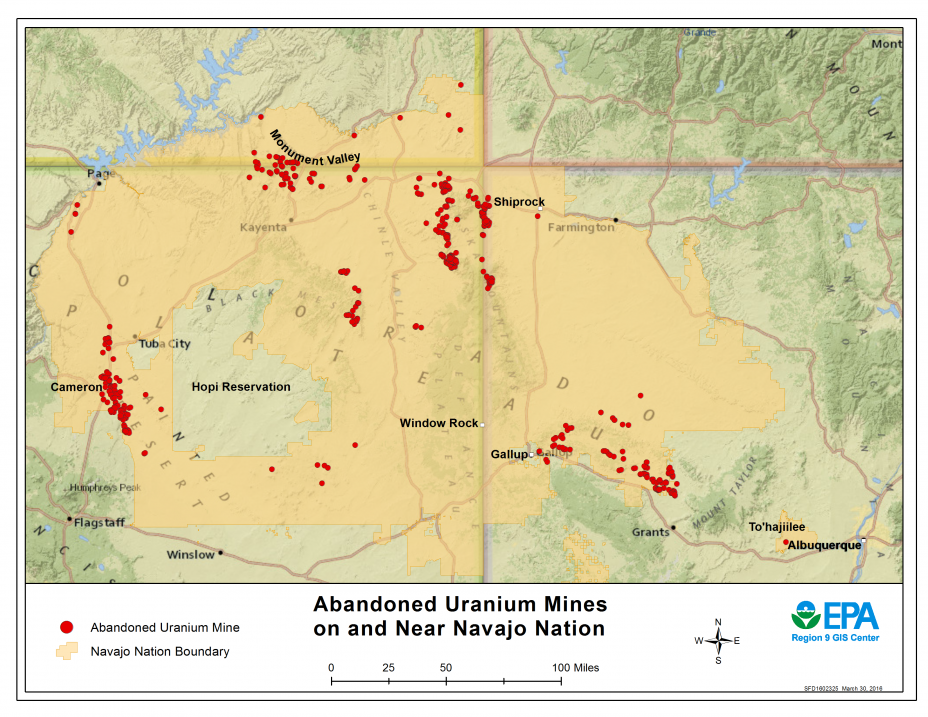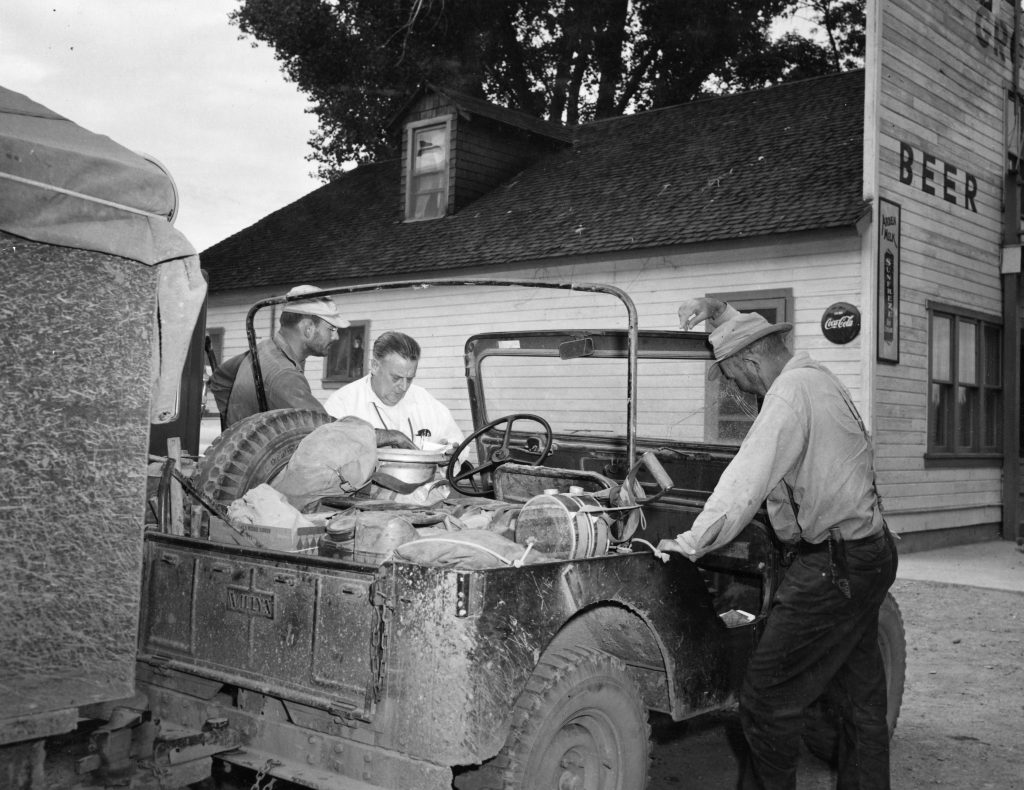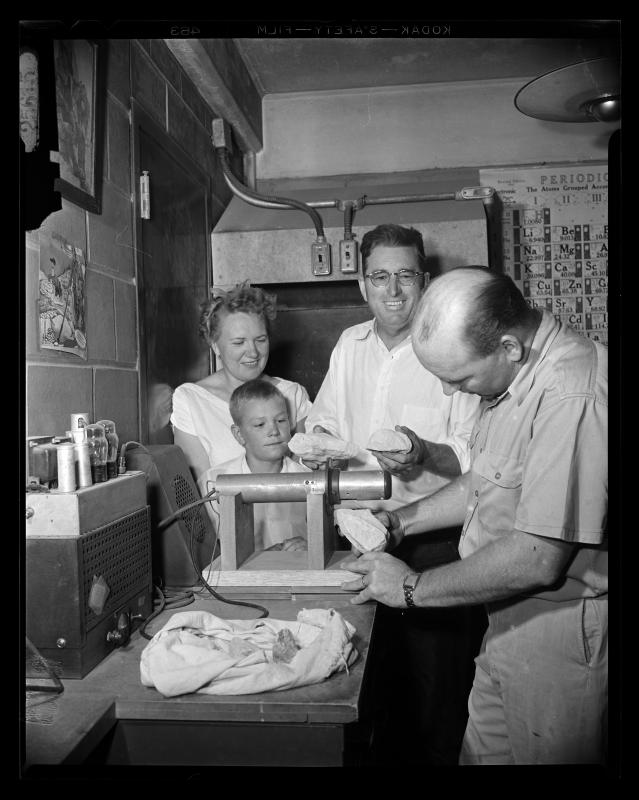By Nate Housley
During the uranium boom of the 1950s, thousands of would-be prospectors flooded into the “four corners” region of the Colorado Plateau hoping to strike it rich. The federal government’s Atomic Energy Commission (AEC) sponsored this search, advertising fixed rates for uranium ore along with bonuses for new discoveries.
While the uranium boom introduces a host of historical questions, as a labor historian my interest is on how the government structured the work that would produce uranium. AEC designed the domestic uranium procurement program as a free enterprise program, meaning that the government would not find the ore itself or own and operate the mines and mills. The government merely offered payment to anyone who took it upon themselves to find and produce ore.
I came to this topic when my colleague Rachel Wittmann, digital curation librarian at the University of Utah’s Marriott Library, approached me to contribute to a digital exhibition. Mining in the West, an extensive, multi-faceted exploration of Western mining, is a joint product of the Marriott Library and the Utah Museum of Fine Arts. I hope that my contribution does justice to the topic of uranium mining and to the rich source material found in the library’s Uranium Oral Histories collection.
The stated reasoning for the AEC’s domestic uranium procurement program was to quickly develop a domestic source of uranium, which the Department of Defense would use in building up a nuclear arsenal. Previously, the federal government had sourced uranium mainly from (what was then) the Belgian Congo. Now looking to source the material from the Colorado Plateau, AEC bureaucrats stated to the public that free enterprise would efficiently draw upon the knowledge of the existing prospectors in the region–preferable to a bloated, top-down operation headed by the government. AEC employee Gilmor Ritter stated in an oral history, “Private industries would run this business because any time that the government is involved . . . it cost you [taxpayers] money.”[1] Proponents of the free enterprise system pointed to the fact that by 1958–a mere decade since the announcement of the program–the government had secured enough uranium for its nuclear arsenal. Yet evidence suggests that the program was also designed for the expediency of the commission itself, especially in response to organized labor. The costs of this expediency can be measured in human life.

As the general public now knows, radioactive elements such as uranium present serious health hazards. Radon gas, a byproduct of uranium, filled the mines where the AEC was getting its ore. Once released from uranium ore, radon gas quickly decomposes into a variety of “daughter” products, including lead, that can cause cancer if they enter the bloodstream. While researchers would not develop a conclusive link between radon and lung cancer until the early 1950s, the federal government had reason to believe from the beginning of the AEC uranium program that there was cause for concern.
An internal AEC memo from 1948–the same year that the commission announced its program–indicates that the commission worked to keep research about radon classified: “We can see the possibility of a shattering effect on the morale of the employees if they [the employees] become aware that there was substantial reason to question the standards of safety under which they are working. In the hands of labor unions the results of this study would add substance to demands for extra-hazardous pay.”[2] Even after it had been determined that increased ventilation could greatly reduce the danger of unhealthy concentrations of radon, the AEC dragged its feet in publicizing the dangers of radon gas and took a lax approach to mining inspections.
The AEC had been engaged in labor disputes for a few years, which helps to explain the memo’s note of resentment toward unions. During World War II, in two of the AEC’s facilities in Tennessee where uranium was purified, the workforces had unionized, each under a different labor federation. The American Federation of Labor and the Congress of Industrial Organizations competed to win over the workers of the other facility, which put the War Department in a pinch. In response to threats of a strike, the AEC’s acting director, General Leslie Groves, managed to appeal to national interest to get the labor federations to acquiesce. But when the war ended, workers began bargaining again for higher wages. In 1947, the AEC narrowly avoided a strike.[3]
As a result of these labor disputes, the AEC issued a report on labor relations and held a congressional hearing. The commission argued that work stoppages must be avoided at all cost and that the threat of strikes in atomic energy facilities posed a threat to national security. Rejecting the feasibility of an outright ban on labor unions or on striking, the AEC’s conclusion was to recommend “the use of private management institutions”–namely, private contractors.[4]
Generally speaking, Washington DC was pivoting toward the anti-communism that would characterize the Cold War. David Lilienthal, in his hearings to become the AEC’s new director after it passed out of military jurisdiction, had to respond to innuendo about his mother simply because she had immigrated from a part of the USSR. He also faced suspicion because he had previously helmed the Tennessee Valley Authority, one of Franklin Roosevelt’s “socialist” New Deal programs.[5] By 1947 Roosevelt’s agenda of expansive government programs and strong labor protections had been on the retreat. That year also marked passage of the Taft-Hartley Act–legislation that repealed many of the labor protections of 1935’s Wagner Act. By looking to private contractors on the Colorado Plateau as a way out of big labor’s grip on industry, the AEC was foreshadowing the subsequent relocation of eastern industrial firms’ operations to “Sun Belt” cities where union density was much lower.
Oral histories conducted in the 1970s indicate that individuals living on the Colorado Plateau largely accepted the AEC’s free enterprise system with enthusiasm. H. Byron Mock, an attorney working on behalf of uranium prospectors, thought that the uranium boom “taught us that the harnessing of the self-interest of . . . American ingenuity and will to do is probably one of the most effective means for surmounting obstacles that might never be overcome if you allowed it only to a planned society.”[6] The Cold War, as we can see in the reference to the “planned society” of the USSR and its allies, was well underway. The free enterprise system was the antidote.

While the prospectors themselves generally did not articulate their views of political economy in the same lofty manner as attorneys, they tended to voice their disapproval of Big Government in other ways. They suspected corruption among the AEC, complained about people who collected welfare, and resented safety inspections in their mines. As the prospector Robert Hancock said, “If I lived up to all the federal mining regulations, why that’s all I’d do, is adhere to them. I wouldn’t put ore out, I’d just be running around taking care of all these rules and regulations.”[7] Dr. Gary Shumway, the historian who headed the oral history project, characterized the complaints of the prospectors thusly: “They chanted an anti-AEC liturgy, told tales of government inefficiency, and warned against creeping socialism.”[8]
What is interesting is that “federal mining regulations” were virtually non-existent until the very end of the AEC program. In 1951, the Public Health Service recommended ventilating uranium mines to dilute radon gas, which they had found would “probably cause injury to the miners.” (Even the Public Health Service displayed a level of disregard for the miners, by studying the effects of radiation on miners in 1950 without notifying them of the potential hazards.)[9] Yet the federal government left regulation to the states, claiming an inability to enter privately owned mines. This decision, however, ignored a 1936 law that allowed the federal government to regulate safety concerns for its contractors.[10]
Though the federal government had tasked them with inspections, the states were poorly equipped to regulate radiation in uranium mines. At the beginning of the AEC program, Colorado only had two mine inspectors for the entire state. Utah did not enforce standards until the 1960s, and Arizona reportedly did “nothing outside of tak[ing] air samples.”[11] The AEC finally issued a pamphlet about the dangers of radon in 1959, after the boom years had ended. It wasn’t until 1967 that the federal government established an enforceable standard for radon, four years before the AEC stopped buying uranium. In this environment of poor communication and lax regulation, uranium miners either ignored the threat or attributed instances of lung cancer in their family members and colleagues to cigarettes.
In an oral history, a doctor illustrates the stark contrast between the government’s facility at Los Alamos–part of the Manhattan Project where the atomic bomb was developed–and a mill at Uravan, Colorado.
I was appalled coming out of Los Alamos where everything was so strictly and constantly monitored with regard to radiation of any type, alpha, beta, gamma, the whole gamut. You couldn’t do anything there with a monitor being continuously at your side telling you, ‘Don’t go in there. Don’t do this. You have enough for a day, go home,’ to Uravan where nobody knew anything about nothing with regard to radiation. Absolutely nothing. I was appalled. Of course as it turned out many of these houses were built on these old fills and they were hotter than hell [radioactive]. I hold the Atomic Energy as responsible for that nonsense. They knew this.[12]

Over time, more people who were exposed to uranium developed illnesses, and research further solidified the link between radon and cancer. Many of the victims were Diné (Navajo), since much of the uranium ore was found on the Navajo Nation. Thousands of Diné men worked in the mines, and the proximity of their families and communities to the more than one thousand mines meant that women and children suffered the ill effects as well. Mine tailings polluted the water sources of many of these communities. Among all miners, more than half of lung cancer cases were caused by radon, resulting in as many as six hundred deaths.[13]
Diné advocacy for radiation victims began in the early 1960s as groups of widows began to organize. It would take decades before they would achieve any recompense. In 1978, former Secretary of the Interior Stewart Udall began working with Diné activists and soon after filed a lawsuit against the Department of Energy (formerly the AEC). The case, Begay v. United States, concluded in federal district court in 1984. Even though the court stated that the situation “cries for redress,” it ruled that the United States was immune to suit because it had been acting in its own interest for national security.
While Begay v. United States did not result in a satisfactory outcome for the miners, it paved the way for the Radiation Exposure Compensation Act of 1990. The Clinton administration investigated the AEC domestic uranium procurement program and issued a damning report in 1995. The report concludes, “The government failed to act to require the reduction of the hazard by ventilating the mines, and it failed to adequately warn the miners of the hazard to which they were being exposed.”[14] These actions began a process of retribution for the miners and families who suffered from the effects of uranium. The government has since settled the cases of about eight thousand uranium miners and millers for a total of $788 million dollars[15]. The government continues to remediate abandoned uranium mines on and around the Navajo Nation, but as of 2017, only about twenty percent have been designated for cleanup.

The unwillingness of the federal government to take responsibility for the health and safety of the workers who provided fuel for its nuclear arsenal represents one chapter in a longer story of harmful, negligent treatment of westerners in the name of national defense. Aside from the uranium program, atomic bomb testing in the deserts of Utah and Nevada saturated rural communities and military members with radiation while the federal government lied about the harms of these experiments.
Even in hindsight, the uranium program defies easy takeaways. Many of its components were not what they seemed. Rugged individualists were on the lookout for a Big Government that did too much rather than too little. Some on the Navajo Nation looked forward to jobs close to home and royalties from mining leases. Federal employees were helping to harm these populations while they thought they were acting in the name of national defense. If free enterprise promises big rewards for those with the right combination of work ethic, creativity, and good luck, then the uranium program delivered. A few individuals went from rags to riches by finding a “bonanza.” But if the corollary is a full awareness of the risks involved, then the success of the AEC’s program becomes much more dubious.
[1] Gilmor C. Ritter, interview, July 21, 1970, transcript, Uranium History Series: 23. See also “Report on Labor Problems Relating to Continuity of Production in the Atomic Energy Commission Program,” from Labor Policy in Atomic Energy Plants, before the Joint Committee on Atomic Energy, Eightieth Congress.
[2] United States, Final Report of the Advisory Committee on Human Radiation Experiments, 1995, chapter 13: “The Practice of Secrecy.”
[3] Richard G. Hewlett and Francis Duncan, Atomic Shield, 1947-1952 (U.S. Atomic Energy Commission, 1972).
[4] “Report on Labor Problems Relating to Continuity of Production in the Atomic Energy Commission Program,” from Labor Policy in Atomic Energy Plants, before the Joint Committee on Atomic Energy, Eightieth Congress, p. 125 (1948).
[5] Hewlett and Duncan, Atomic Shield.
[6] H. Byron Mock, interview, August 11,1970, transcript, Uranium History Series.
[7] Robert V. Hancock, interview, August 6, 1970, transcript, Uranium History Series.
[8] Gary Lee Shumway, “A History of the Uranium Industry on the Colorado Plateau” (PhD diss., University of Southern California, 1970).
[9] Final Report of the ACHRE, chapter 12.
[10] Final Report of the ACHRE, chapter 12.
[11] Final Report of the ACHRE, chapter 12.
[12] Dr. & Mrs. Leroy Edward Ellinwood, interview, July 23, 1970, transcript, Uranium History Series.
[13] Doug Brugge and Rob Goble, “The History of Uranium Mining and the Navajo People,” American Journal of Public Health 92 no. 9 (September 2002), https://ajph.aphapublications.org/doi/pdf/10.2105/AJPH.92.9.1410.
[14] Final report of the ACHRE.
[15] U.S. Department of Justice, “Radiation Exposure Compensation Fund,” https://web.archive.org/web/20160318033248/https://www.justice.gov/civil/awards-date-03172016.

